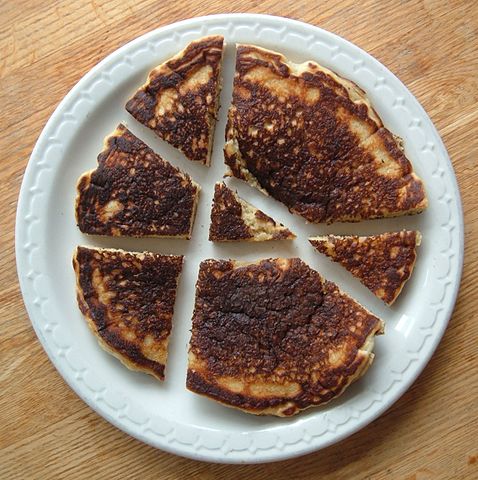
If you apply one straight cut to a pancake, pretty clearly you’ll get 2 pieces. With two cuts, the most you can get is 4. What’s the greatest number you can produce with three cuts? If the cuts meet neatly in the center, you’ll get 6 pieces, but if you’re artfully sloppy you can make 7 (above). Charmingly, this leads us into the “lazy caterer’s sequence” — the maximum number of pieces you can produce with n straight cuts:
1, 2, 4, 7, 11, 16, 22, 29, 37, 46, 56, 67, 79, 92, 106, 121, 137, 154, 172, 191, 211, …
Generally it turns out that the maximum number for n cuts is given by the formula
each number equals 1 plus a triangular number.
A related question is the pancake flipping problem. You’re presented with a spatula and an untidy stack of pancakes of varying sizes. You can insert the spatula at any point in the stack and flip all the pancakes above it. What’s the least number of flips required to sort the pancakes in order of size? Interestingly, no one has found a general answer. It’s possible to work out the solution for relatively small stacks (in which the number of pancakes is 1, 2, 3, …):
0, 1, 3, 4, 5, 7, 8, 9, 10, 11, 13, …
But no one has found a formula that will tell how many flips will get the job done for a stack of any given size.
The problem has an interesting pedigree. Bill Gates worked on it at Harvard (PDF), and David X. Cohen, who went on to write for The Simpsons and Futurama, worked on a related problem at Berkeley in which the bottom of each pancake is burnt and the sort must be completed with the burnt sides facing down.
CCNY mathematician Jacob Goodman, who first hit on the pancake flipping problem while sorting folded towels for his wife, submitted it to the American Mathematical Monthly under the name Harry Dweighter (“harried waiter”). His household chores have produced at least one other publication: After some thoughtful work with a swivel-bladed vegetable peeler, he published “On the Largest Convex Polygon Contained in a Non-convex n-gon, Or How to Peel a Potato.”
(Thanks, Urzua.)
